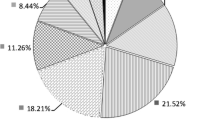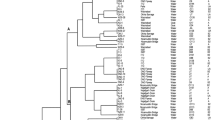Abstract
Spatial correlation of pollution of the water resource in Taipei, Taiwan, were examined by analyzing the antibiotic resistance patterns (ARPs) of 96 Escherichia coli colonies, which were isolated from 7 sampling sites in 3 river sections. The ARPs were the growth patterns of isolated E. coli colonies in the medium with seven kinds of antibiotics, including ampicillin, chlortetracycline, erythromycin, oxytetracycline, streptomycin, tetracycline, and salinomycin of different concentrations. The results showed that the survival rate of E. coli decreased with increasing concentration of antibiotics; however, various ARPs under different antibiotics of different concentrations significantly increased both the useful information and complexities. Hierarchical cluster analysis (HCA) and two-stage principal component analysis (PCA) were applied to analyze the spatial correlations and interrelations of distinct ARPs among sampling sites in this study. It was found that the seven sampling sites can be categorized into three groups which may represent three possible pollution characteristics.



Similar content being viewed by others

References
Akbal F, Gürel L, Bahadır T, Güler İ, Bakan G, Büyükgüngör H (2011) Multivariate statistical techniques for the assessment of surface water quality at the mid-black sea coast of Turkey. Water Air Soil Pollut 216:21–37
An J, Chen H, Wei S, Gu J (2015) Antibiotic contamination in animal manure, soil, and sewage sludge in Shenyang, Northeast China. Environ Earth Sci 74:5077–5086
Bao Y, Zhou Q, Guan L, Wang Y (2009) Depletion of chlortetracycline during composting of aged and spiked manures. Waste Manag 29:1416–1423
Bengraı̈ne K, Marhaba TF (2003) Using principal component analysis to monitor spatial and temporal changes in water quality. J Hazard Mater 100:179–195
Carrillo M, Estrada E, Hazen TC (1985) Survival and enumeration of the fecal indicators Bifidobacterium adolescentis and Escherichia coli in a tropical rain forest watershed. Appl Environ Microbiol 50:468–476
Chang Y-J, Chang I, Yu T-Y (2017) Spatiotemporal features and delineation of water quality control zones for Taipei water resources district with multivariate manners. Desalin Water Treat 96:255–266
Chang Y-T, Chang Y-J (2014) The investigation of the bacterial indicators and point sources of pollution for the Nanshih River, Taiwan: a case study. Desalin Water Treat 52:1130–1142
Choi S, Chu W, Brown J, Becker SJ, Harwood VJ, Jiang SC (2003) Application of enterococci antibiotic resistance patterns for contamination source identification at Huntington Beach, California. Mar Pollut Bull 46:748–755
Eder B, Davis JM, Monahan JF (1987) Spatial and temporal analysis of the palmer drought severity index over the South-Eastern United States. Int J Climatol 7:31–56
Fu J, Zhao C, Luo Y, Liu C, Kyzas GZ, Luo Y, Zhao D, An S, Zhu H (2014) Heavy metals in surface sediments of the Jialu River, China: their relations to environmental factors. J Hazard Mater 270:102–109
Garizi AZ, Sheikh V, Sadoddin A (2011) Assessment of seasonal variations of chemical characteristics in surface water using multivariate statistical methods. Int J Environ Sci Technol (Tehran) 8:581–592
Guan S, Xu R, Chen S, Odumeru J, Gyles C (2002) Development of a procedure for discriminating among Escherichia coli isolates from animal and human sources. Appl Environ Microbiol 68:2690–2698
Hölzel CS, Schwaiger K, Harms K, Küchenhoff H, Kunz A, Meyer K, Müller C, Bauer J (2010) Sewage sludge and liquid pig manure as possible sources of antibiotic resistant bacteria. Environ Res 110:318–326
Harman HH (1976) Modern factor analysis. University of Chicago Press
Hazen TC (1988) Fecal coliforms as indicators in tropical waters: a review. Environ Toxicol 3:461–477
Horel JD (1981) A rotated principal component analysis of the interannual variability of the northern hemisphere 500 mb height field. Mon Weather Rev 109:2080–2092
Juahir H, Zain SM, Yusoff MK, Hanidza TT, Armi AM, Toriman ME, Mokhtar M (2011) Spatial water quality assessment of Langat River basin (Malaysia) using environmetric techniques. Environ Monit Assess 173:625–641
Kaiser HF (1958) The varimax criterion for analytic rotation in factor analysis. Psychometrika 23:187–200
Koklu R, Sengorur B, Topal B (2010) Water quality assessment using multivariate statistical methods—a case study: Melen River system (Turkey). Water Resour Manag 24:959–978
Leung HW, Minh T, Murphy MB, Lam JC, So MK, Martin M, Lam PK, Richardson BJ (2012) Distribution, fate and risk assessment of antibiotics in sewage treatment plants in Hong Kong, South China. Environ Int 42:1–9
McClellan K, Halden RU (2010) Pharmaceuticals and personal care products in archived US biosolids from the 2001 EPA national sewage sludge survey. Water Res 44:658–668
Mishra A (2010) Assessment of water quality using principal component analysis: a case study of the river Ganges. J Water Chem Technol 32:227–234
Morrison DF (1967) Multivariate statistical methods. McGraw-Hill Book Co., New York
Olsen RL, Chappell RW, Loftis JC (2012) Water quality sample collection, data treatment and results presentation for principal components analysis–literature review and Illinois River watershed case study. Water Res 46:3110–3122
Phung D, Huang C, Rutherford S, Dwirahmadi F, Chu C, Wang X, Nguyen M, Nguyen NH, Do CM, Nguyen TH (2015) Temporal and spatial assessment of river surface water quality using multivariate statistical techniques: a study in can Tho City, a Mekong Delta area, Vietnam. Environ Monit Assess 187:229
Razmkhah H, Abrishamchi A, Torkian A (2010) Evaluation of spatial and temporal variation in water quality by pattern recognition techniques: a case study on Jajrood River (Tehran, Iran). J Environ Manag 91:852–860
Sarmah AK, Meyer MT, Boxall AB (2006) A global perspective on the use, sales, exposure pathways, occurrence, fate and effects of veterinary antibiotics (VAs) in the environment. Chemosphere 65:725–759
Shrestha S, Kazama F (2007) Assessment of surface water quality using multivariate statistical techniques: a case study of the Fuji river basin, Japan. Environ Model Softw 22:464–475
Singh KP, Malik A, Mohan D, Sinha S (2004) Multivariate statistical techniques for the evaluation of spatial and temporal variations in water quality of Gomti River (India)—a case study. Water Res 38:3980–3992
Singh KP, Malik A, Sinha S (2005) Water quality assessment and apportionment of pollution sources of Gomti river (India) using multivariate statistical techniques—a case study. Anal Chim Acta 538:355–374
Tran CP, Bode RW, Smith AJ, Kleppel GS (2010) Land-use proximity as a basis for assessing stream water quality in New York state (USA). Ecol Indic 10:727–733
Walczak M, Donderski W (2007) Elimination of indicators (TC, FC, FS) and Enterobacteriaceae family bacteria during the sewage treatment process. Pol J Nat Sci 22:294–304
Wu J, Li P, Qian H, Duan Z, Zhang X (2014) Using correlation and multivariate statistical analysis to identify hydrogeochemical processes affecting the major ion chemistry of waters: a case study in Laoheba phosphorite mine in Sichuan, China. Arab J Geosci 7:3973–3982
Yang C, Lin M, Liao P, Yeh H, Chang B, Tang T, Cheng C, Sung C, Liou M (2009) Comparison of antimicrobial resistance patterns between clinical and sewage isolates in a regional hospital in Taiwan. Lett Appl Microbiol 48:560–565
Zhang B, Song X, Zhang Y, Han D, Tang C, Yu Y, Ma Y (2012) Hydrochemical characteristics and water quality assessment of surface water and groundwater in Songnen plain, Northeast China. Water Res 46:2737–2748
Zuccato E, Castiglioni S, Fanelli R (2005) Identification of the pharmaceuticals for human use contaminating the Italian aquatic environment. J Hazard Mater 122:205–209
Author information
Authors and Affiliations
Corresponding author
Additional information
Responsible editor: Robert Duran
Rights and permissions
About this article
Cite this article
Yu, TY., Chin, CJ.M. & Chang, YJ. Application of Escherichia coli antibiotic resistance patterns for contamination source identification in watershed. Environ Sci Pollut Res 26, 33936–33945 (2019). https://doi.org/10.1007/s11356-018-2747-y
Received:
Accepted:
Published:
Issue Date:
DOI: https://doi.org/10.1007/s11356-018-2747-y



